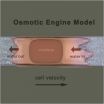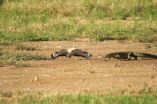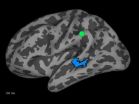(Press-News.org) Johns Hopkins researchers have discovered a new mechanism that explains how cancer cells spread through extremely narrow three-dimensional spaces in the body by using a propulsion system based on water and charged particles.
The finding, reported in the April 24 issue of the journal Cell, uncovers a novel method the deadly cells use to migrate through a cancer patient's body. The discovery may lead to new treatments that help keep the disease in check. The work also points to the growing importance of studying how cells behave in three dimensions, not just atop flat two-dimensional lab dishes.
Based on such lab dish studies, cancer researchers had concluded that tumor cells require actin and other proteins to form arm-like extensions to "crawl" across the flat surfaces. This type of travel was believed to be the primary means of how cancer spreads within a patient, a process called metastasis. Based on this conclusion, researchers have been working on ways to disable actin and its molecular helpers, hoping this can keep cancer from spreading.
But in a study published in 2012, a Johns Hopkins team led by Konstantinos Konstantopoulos, chair of the Department of Chemical and Biomolecular Engineering, found that tumor cells could move through narrow spaces without using actin and its biochemical partners.
"That was a stunning discovery, not in line with the prevailing beliefs about how cells migrate," Konstantopoulos said. "So we wanted to figure out exactly how the tumor cells were able to move through these spaces without relying on actin."
He collaborated with Sean X. Sun, a Johns Hopkins associate professor of mechanical engineering with experience in math modeling and physics at microscopic levels.
"The mystery we needed to solve," Sun said, "was how the cells in these confined spaces could still move when you took away their usual 'engine,' the actin."
Kostantopoulos said Sun and Hongyuan Jiang, a postdoctoral fellow working in Sun's lab, "came up with a phenomenal mathematical model that provided insights into how the cells might use a different system to travel." Then Konstantopoulos and other team members, including Kimberly Stroka, a postdoctoral fellow in his own lab, used a microfluidic lab-on-a-chip and imaging techniques to conduct experiments establishing the new mechanism of migration proposed by Sun and Jiang's model. The tests utilized human and animal cancer cells. Stroka and Jiang were designated co-lead authors of the resulting journal article.
As reported in the article, the tumor cells' new "engine" turned out to be a combination of sodium-hydrogen ions, cell membrane proteins called aquaporins, and water. The researchers found that within tight spaces, cancer cells create a flow of liquid that takes in water and ions at a cell's leading edge and pumps them out the trailing edge, propelling the cell forward. In the actin-dependent migration model, the cell is pushed forward by the biochemical equivalent of a boat engine. The water-based mechanism, the researchers said, more closely resembles the way a sailboat is thrust ahead by gusts of wind. The team called this mechanism the Osmotic Engine Model.
"This discovery is important because it reveals one reason why some diseases like cancer don't always respond to certain treatments," Konstantopoulos said. Sun added, "It's because these diseases have redundant mechanisms—more than one method—for migrating through the body."
INFORMATION:
The Johns Hopkins researchers are applying for funds to conduct further research into physical and biological aspects of the Osmotic Engine Model. Their hope is that the work will uncover a way to shut down this biochemical engine and keep it from spreading tumor cells.
The multidisciplinary research at Johns Hopkins was conducted within the university's Institute for NanoBioTechnology and its Physical Sciences-Oncology Center. These organizations and the departments of Chemical and Biomolecular Engineering and Mechanical Engineering are based in the Whiting School of Engineering.
Co-lead author of the Cell article Stroka will join the faculty of the University of Maryland College Park as an assistant professor later this year. Whiting School postdoctoral fellow Jiang, the other lead author, is now a professor at the University of Science and Technology of China. Kostantopoulos and Sun supervised the research and served as senior authors of the paper. Other co-authors, all from Johns Hopkins, were Shih-Hsun Chen, Ziqiu Tong and Denis Wirtz.
This work was supported by National Science Foundation grant NSF-1159823, National Cancer Institute grants U54-CA143868, RO1GM075305, RO1CA174388, T32-CA130840 and F32-CA177756, a Kleberg Foundation grant and National Natural Science Foundation of China grant NSFC 11342010.
An illustration depicting the Osmotic Engine Model is available; contact Phil Sneiderman.
Related Links:
Konstantinos Konstantopoulos' Website:
http://www.jhu.edu/chembe/faculty-template/KonstantinosKonstantopoulos.html
Sean X. Sun's Website: http://web1.johnshopkins.edu/~sungroup/?lab-member=sean-x-sun
Johns Hopkins Institute for NanoBioTechnology: http://inbt.jhu.edu/
Johns Hopkins Physical Sciences-Oncology Center: http://psoc.inbt.jhu.edu/
Whiting School of Engineering: http://engineering.jhu.edu
Department of Chemical and Biomolecular Engineering:
http://engineering.jhu.edu/chembe/
Department of Mechanical Engineering: http://www.me.jhu.edu/
A video accompanying this release can be viewed at http://youtu.be/6TtXEGo4rlc .
Water-based 'engine' propels tumor cells through tight spaces in the body
2014-04-30
ELSE PRESS RELEASES FROM THIS DATE:
Frog eggs Help MU researchers find new information on grapevine disease
2014-04-30
COLUMBIA, Mo. – Vitis vinifera are common grapevines and are the world's favorite wine-producing varietal. However, research has shown that grapevines are susceptible to powdery mildew, a plant disease, which contributes to significant crop loss for most commercial wine varietals that are cultivated each year. Now, researchers at the University of Missouri have used frog eggs to determine the cause of this disease, and have found that a specific gene in the varietal Cabernet Sauvingon, contributes to its susceptibility.
"Powdery mildew disease causes the leaves of the ...
Predators predict longevity of birds
2014-04-30
This news release is available in German. Ageing inevitably occurs both in humans and in other animals. However, life-span varies widely across species. Researchers of the Max Planck Institute for Ornithology in Seewiesen have now found a possible general mechanism explaining differences in longevity. They investigated life history data of nearly 1400 bird species and found that avian life span varies considerably across the entire Earth, and that much of this variation can be explained by the species' body mass and clutch size and by the local diversity of predator ...
Your stress is my stress
2014-04-30
This news release is available in German. Stress is contagious. Observing another person in a stressful situation can be enough to make our own bodies release the stress hormone cortisol. This is the conclusion reached by scientists involved in a large-scale cooperation project between the departments of Tania Singer at the Max Planck Institute for Cognitive and Brain Sciences in Leipzig and Clemens Kirschbaum at the Technische Universität Dresden. Empathic stress arose primarily when the observer and stressed individual were partners in a couple relationship and the ...
A fattening gene
2014-04-30
This news release is available in German. The long-term consumption of too much high-energy and high-fat food leads to overweight. Behind this trivial statement lies the extremely complex regulation of lipid metabolism. Together with colleagues from Japan, scientists from the Max Planck Institute for Heart and Lung Research in Bad Nauheim have now discovered that the Sirt7 gene plays a central role in energy metabolism. Despite consuming high-fat food, genetically modified mice that lack the gene maintain their normal weight.
Food was not always available to such ...
In recognizing speech sounds, the brain does not work the way a computer does
2014-04-30
VIDEO:
Patterns of activation induced by listening to human speech move across brain hemispheres over a period of 300 milliseconds in these images, produced by combining data from EEG, MEG and...
Click here for more information.
How does the brain decide whether or not something is correct? When it comes to the processing of spoken language – particularly whether or not certain sound combinations are allowed in a language – the common theory has been that the brain applies a ...
Social media users need help to adjust to interface changes
2014-04-30
Social media companies that give users a greater sense of control can ease them into interface changes, as well as curb defections to competitors, according to researchers.
"Several studies have looked into how social media companies have failed," said Pamela Wisniewski, a post-doctoral scholar in information sciences and technology, Penn State. "What we need to think about is how social media companies can be more adaptive and how they can improve the longevity of their sites.
In a study of the reaction to the introduction of Facebook's Timeline interface between 2011 ...
Parents just as likely to use cell phones while driving, putting child passengers at risk
2014-04-30
Ann Arbor, Mich. — Despite their precious cargo, parents are no less likely to engage in driving distractions like cell phone use than drivers from the general population, according to a new University of Michigan study published in
Academic Pediatrics.
The study found that 90 percent of parent drivers said they engaged in at least one of the 10 distractions examined in the study while their child was a passenger and the vehicle was moving, says lead author Michelle L. Macy, M.D., M.S., an emergency medicine physician at the University of Michigan's C.S. Mott Children's ...
Study questions Neandertal inferiority to early modern humans
2014-04-30
The embargo has been lifted for the article, 'Neandertal Demise: An Archaeological Analysis of the Modern Human Superiority Complex.'
An analysis of the archaeological records of Neandertals and their modern human contemporaries has found that complex interbreeding and assimilation may have been responsible for Neandertal disappearance 40,000 years ago, in contrast to many current theories, according to results published April 30, 2014, in the open access journal PLOS ONE by Paola Villa from the University of Colorado Museum and Wil Roebroeks from Leiden University ...
Lymph node ultrasounds more accurate in obese breast cancer patients
2014-04-30
ROCHESTER, Minn. — Mayo Clinic research into whether ultrasounds to detect breast cancer in underarm lymph nodes are less effective in obese women has produced a surprising finding. Fat didn't obscure the images — and ultrasounds showing no suspicious lymph nodes actually proved more accurate in overweight and obese patients than in women with a normal body mass index, the study found. The research is among several Mayo studies presented at the American Society of Breast Surgeons annual meeting April 30-May 4 in Las Vegas.
Researchers studied 1,331 breast cancer patients ...
Surgeons and health care settings influence type of breast cancer surgery women undergo
2014-04-30
TORONTO, April 30, 2014 – Breast cancer is one of the few major illnesses for which physicians may not recommend a specific treatment option. North American women are more likely to opt for precautionary breast surgery when physicians don't specifically counsel against it, according to a new study.
The research, presented today at the American Society of Breast Surgeons Annual Meeting in Las Vegas, also demonstrates how clarity during consultations and the capability of clinical facilities also play important roles influencing a woman's breast cancer treatment choices.
There ...





